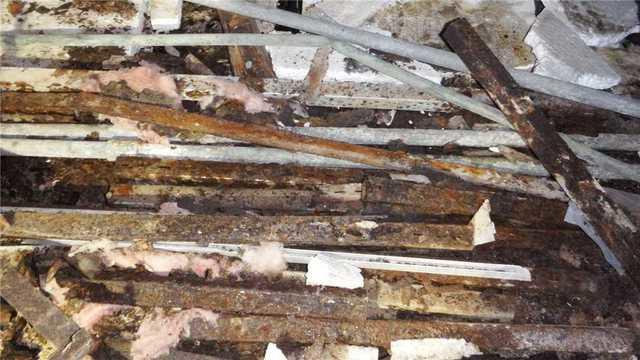
Sinking Floor Above Crawl Space
Sinking floors are due to the rotting or otherwise insufficient support beams in the crawl space. In this case, we needed heavy reinforcement of the beams in order to support the house.

There's a Problem When Mold is Growing on a Spider
I mean, one way to get rid of the spiders in your basement is to have such a bad mold problem that it literally grows on them and kills them. Note the mold all throughout the neighboring beams.

The Culprit: Crawl Space Vents
Now, we can't blame the entirety of the water problems on crawl space vents, but. There were eight. That's a lot of entry points for debris and water and basically any number of gross things.

Discoloration Points to Crawl Space Vents
When your walls are discolored under the crawl space vents...maybe they're the problem?

Rust and Rot in Moldy Crawl Space
There are years of rust and rot on this pipe and beam. Both are caused by water and present based on their base material. Water warps wood and allows mold to grow, which helps rot the wood further. Metal rusts and weakens.

Warped, Rotting Rim Joist
The entire area around the rim joist in the crawl space was rotting out, which leads to the floors in the house sinking as their support fails.

Wet, Moldy Debris in Alpena Crawl Space
Fallen insulation and building material scraps are basically an all you can eat buffet for the mold infesting this crawl space.

Mold Covers Debris in Crawl Space
Mold needs moisture and organic material in order to grow. It has both in spades in this crawl space, with near 90% humidity and fiberglass insulation and boards strewn about. Once mold is growing, and especially once it's to this degree, it can be very difficult to get under control.

The Beginnings of Mold Damage on Support Beams
Not every beam in the crawl space was as severe as some we've shown. But even the at-first-glance-ok parts had mold growing, like the smattering here. The thing about mold is that it's microscopic, so by the time you can see even small patches, that's millions of spores.

Rotting Joist Near Crawl Space Vent
Another part of the joist that is failing due to water/mold damage. Also, can we talk about the irony of insulating/sealing around the edge of a vent? There's air coming in either way.

Severely Warped, Rotting Support in Crawl Space
Aggressive mold and water damage have made this section of the crawl space ceiling (aka the support for the house's floor) dangerous and structurally unsound.

Crawl Space Entry Not Airtight
The key to keeping a crawl space dry is to keep it airtight. That starts with the door.

Signs of Floor Settlement
Baseboards are an excellent way to check if your floors are settling, indicating a problem in your crawl space. As the floor settles, the baseboard will shift with it, creating gaps like you see here.

High Humidity Encourages Mold Growth
Anything over 70% humidity will encourage mold growth in a crawl space. And don't fall for the idea that humidity goes hand in hand with warmth - it's 45 degrees in this crawl space with the humidity at almost 90%

Moldy Fiberglass Insulation
Fiberglass insulation is mold's best friend and a preferred snack. It's a terrible choice for crawl spaces because it feeds mold, but it also absorbs ambient moisture and then falls to the ground when it gets too heavy.

Rotting Sill Plate Needs to be Replaced
Removing some siding revealed the state of the sill plate, which had rotted through and become another entry point for water and mold.

Vent Covers Protect Crawl Space from the Elements
Don't vent your crawl space! Cover the vents if they exist! It's like having a house full of bees and looking at your open front door, wondering how they got in.

Secure, Airtight Crawl Space Access
Now this is a crawl space door. By providing a tight seal at the door, we can prevent water and debris from getting into the crawl space.

SmartJack Reinforces Support Beam
Installing SmartJacks along the support beams gives reinforcement and stabilizes sinking floors.

Rebuilding the Sill Plate
With so much of the sill plate rotting out and allowing even more moisture in, we replaced and rebuilt it with new wood.

Smart Sump Pump Keeps Crawl Space Dry
By installing a sump pump in the crawl space, we're proactively removing the water rather than waiting for it to evaporate on its own. Which it wasn't doing.

IceGuard Prevents Discharge Line Backup
In the winter, discharge lines can freeze and allow water to back up into the crawl space. But IceGuard prevents that by pumping water out through the grate instead.

SaniDry Dehumidifier Combats Ambient Moisture
Once the crawl space is encapsulated and protected from leaks, we need to deal with the ambient moisture that comes from being underground. The SaniDry dehumidifier removes moisture from the air, eliminating mold-producing conditions.

Drainage Matting Helps Transport Water
The dimpled surface of the drainage matting, installed between the ground and the CleanSpace, allows water freer movement.

FrothPak Insulates Hard to Reach Areas
It's not the prettiest, but FrothPak spray insulation is excellent for filling gaps in the rim joist and around other insulation panels.

Joist Reinforcement Strengthens Crawl Space
We installed sister beams to the joists that were warped and beginning to fail.

SilverGlo Panels and Insulate Crawl Space
Rather than fiberglass insulation that absorbs water and then falls in a useless heap, SilverGlo panels provide superior insulation in an inorganic setting. That means mold can't eat them.









